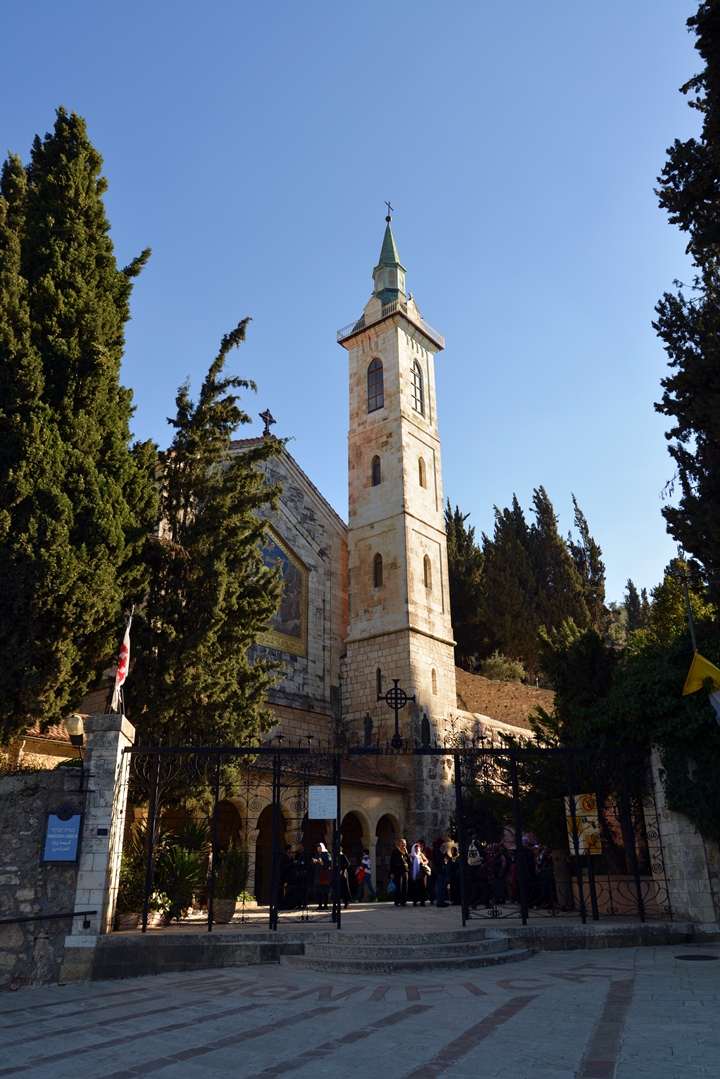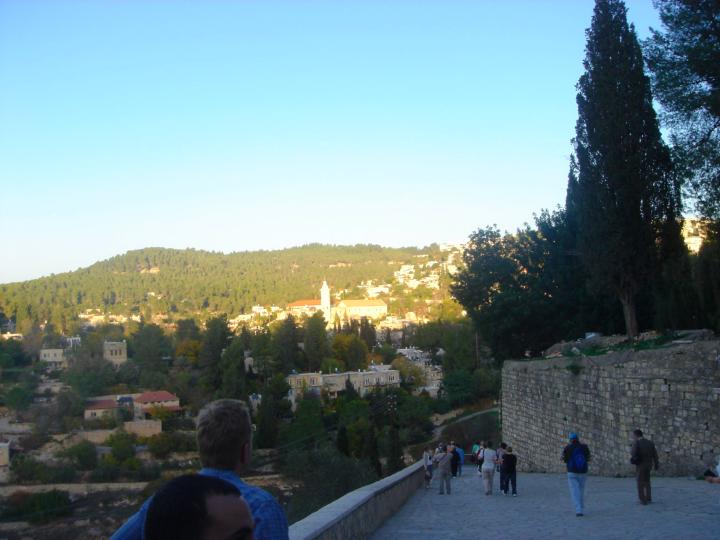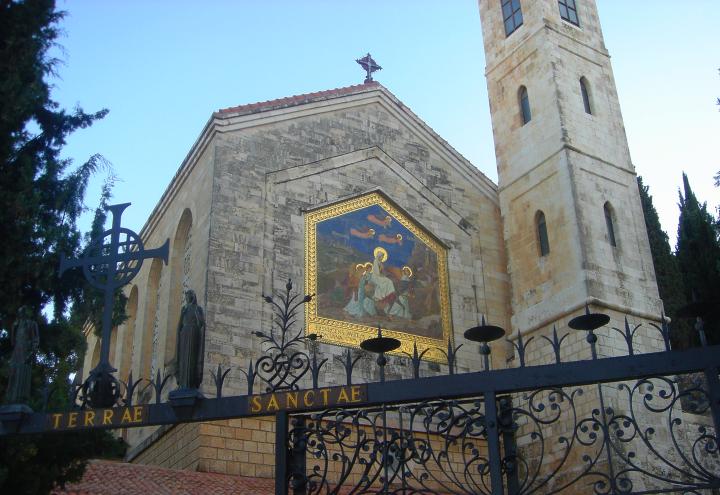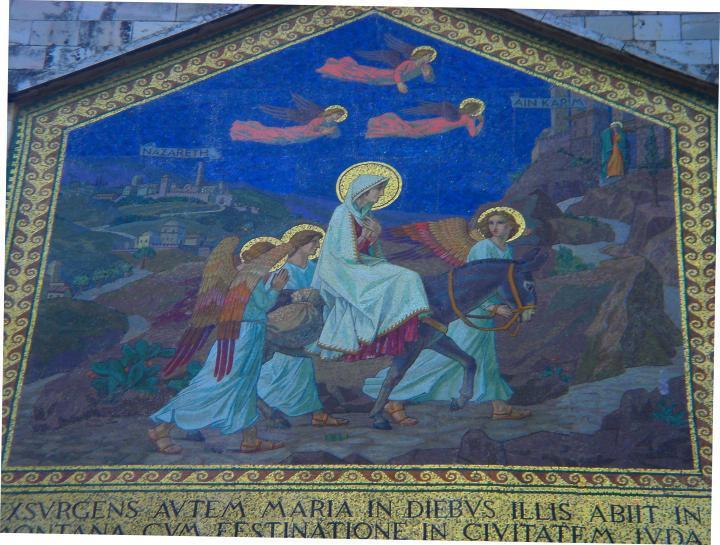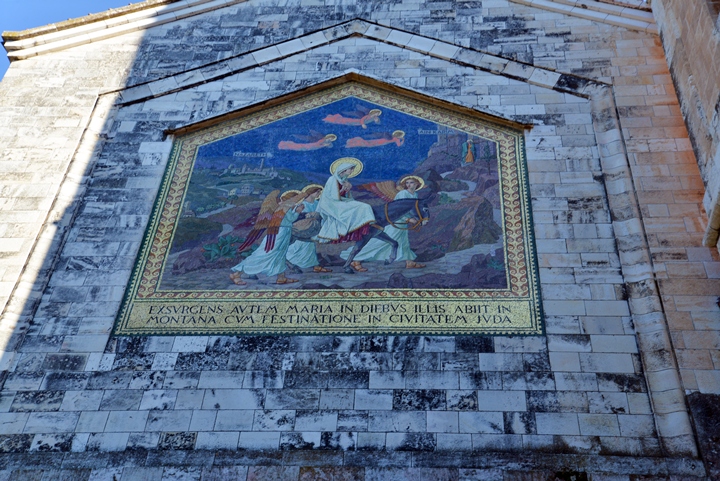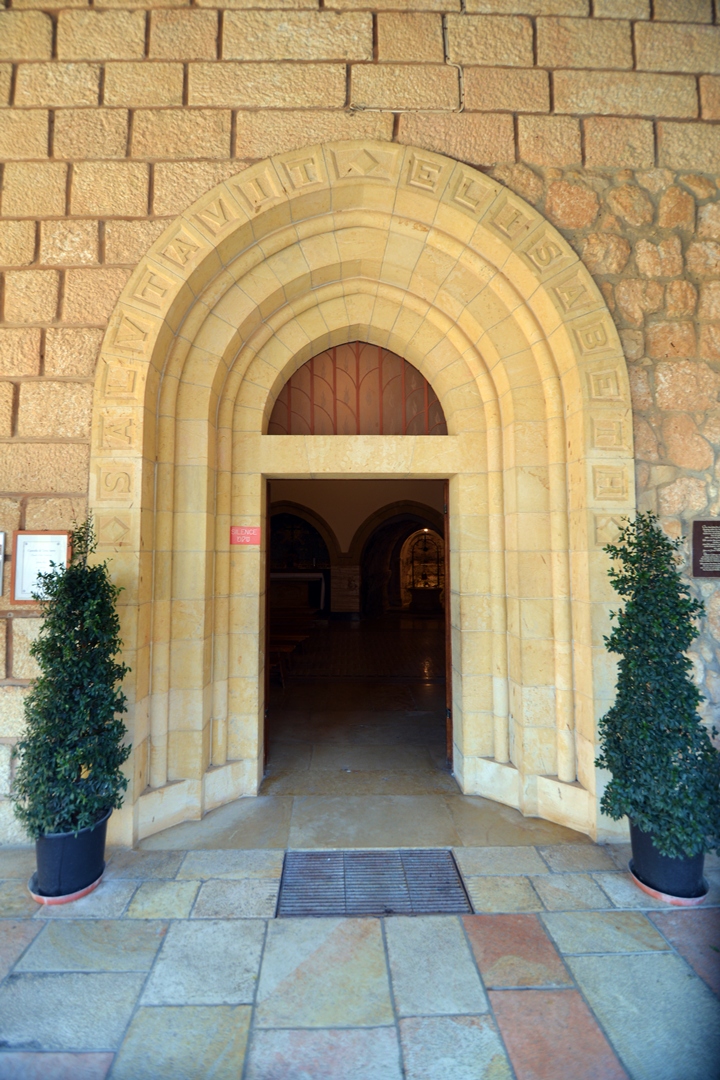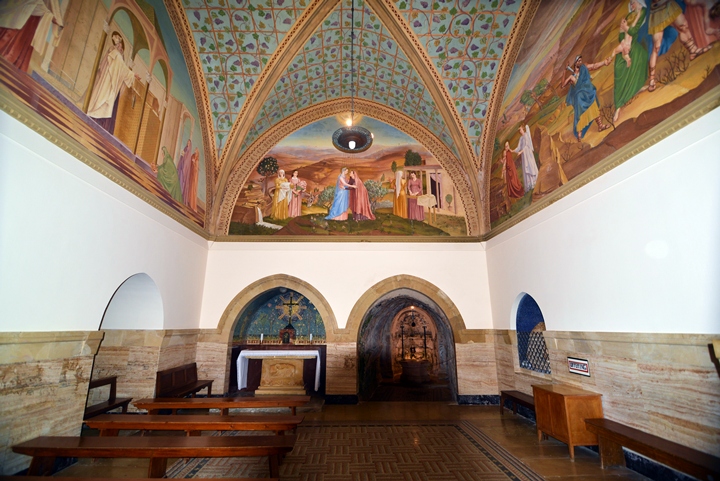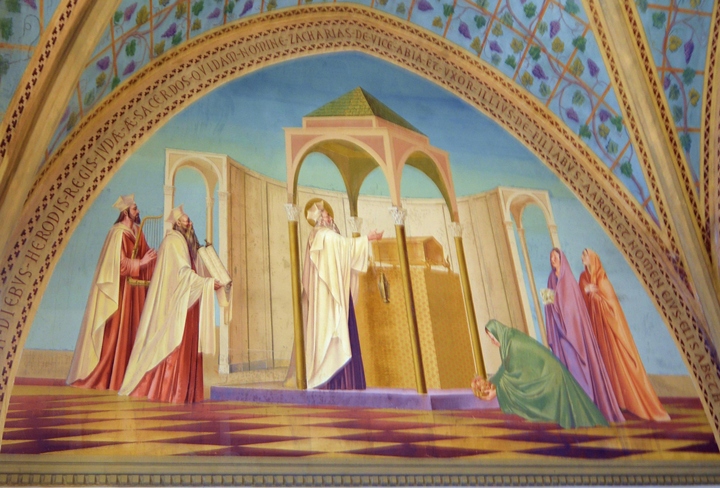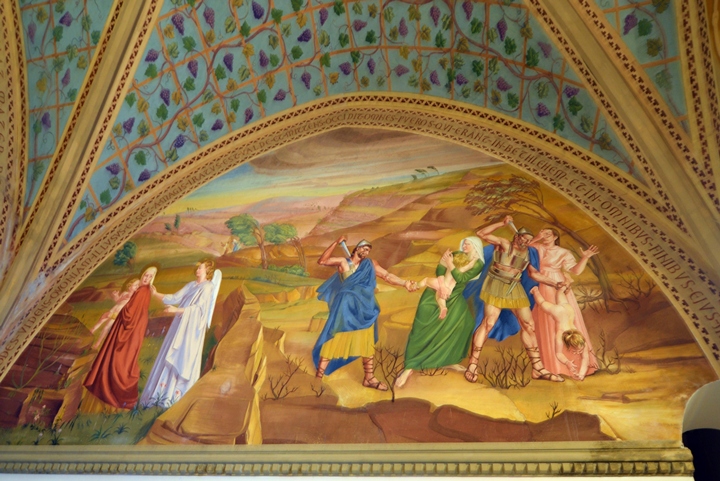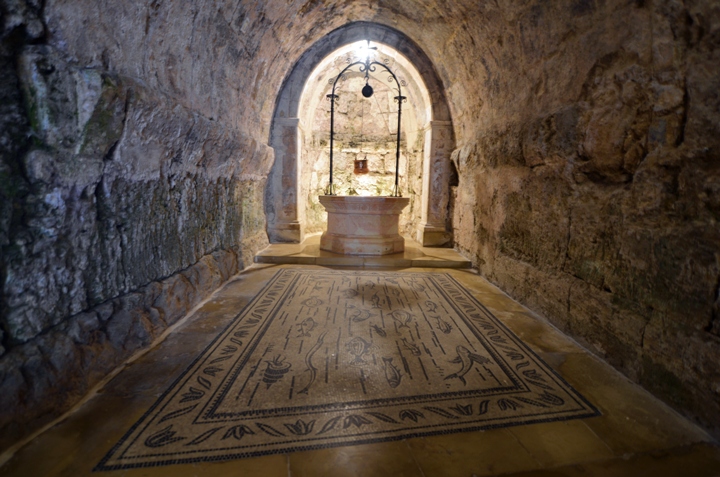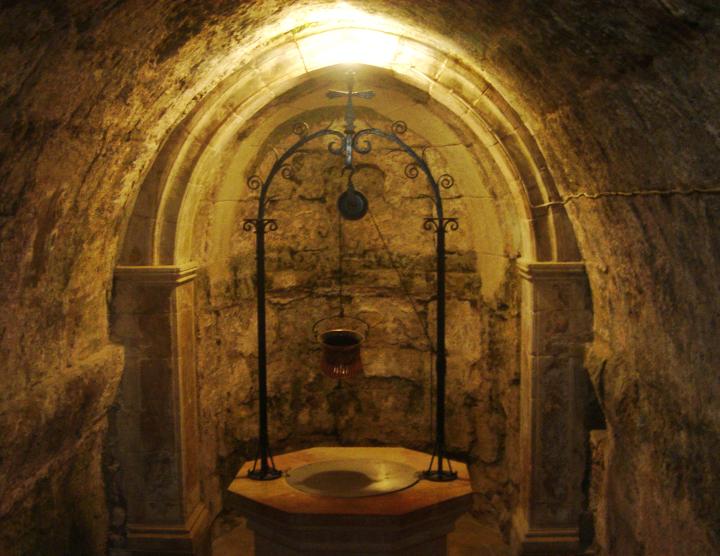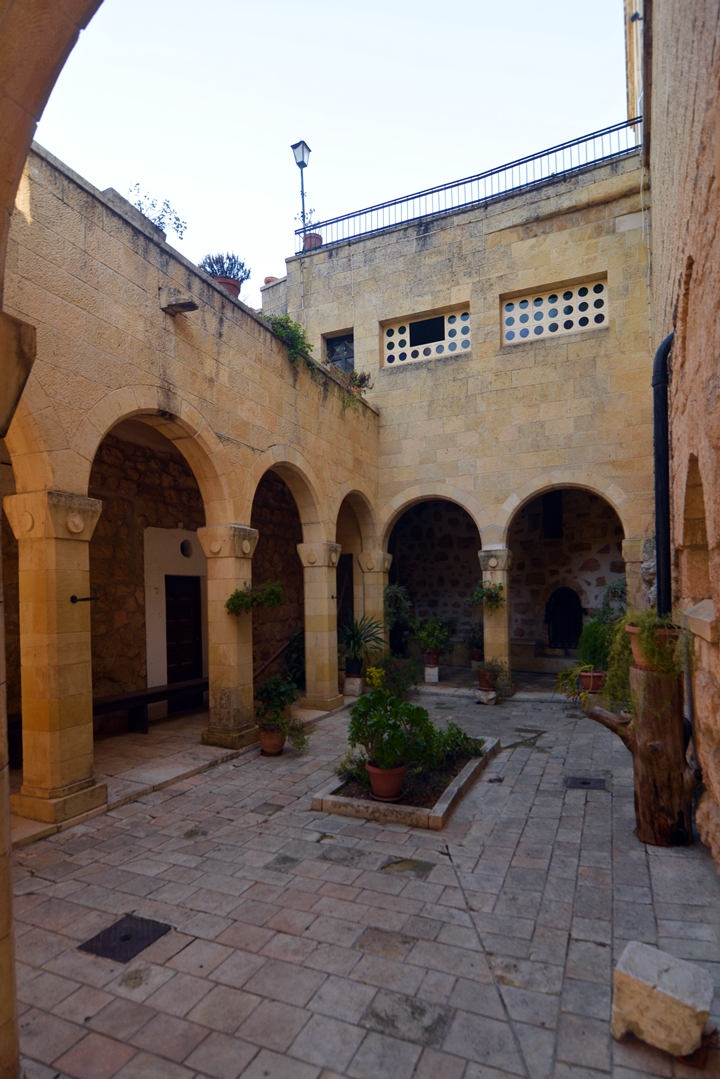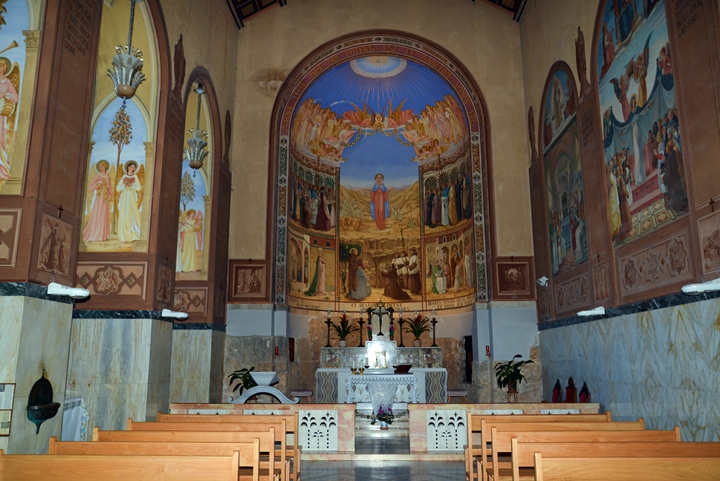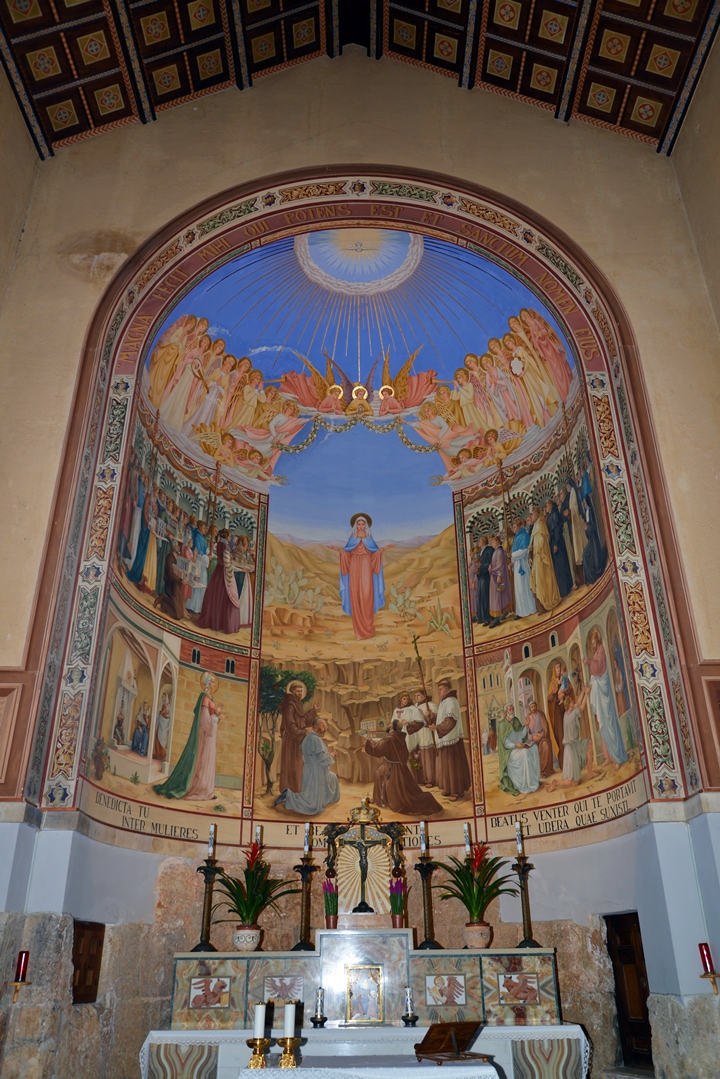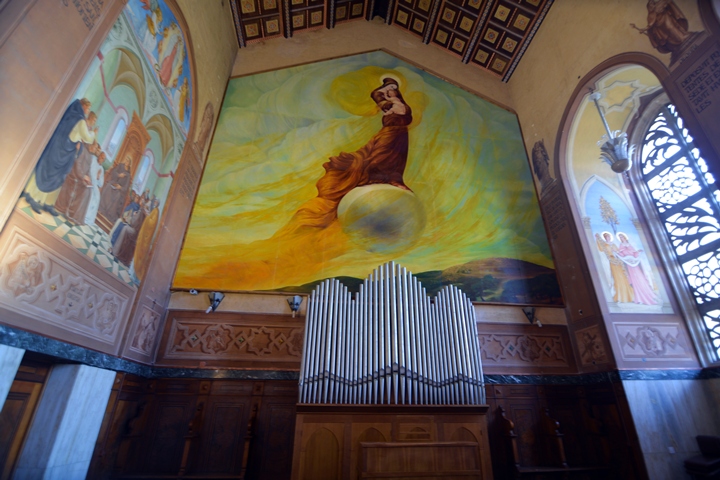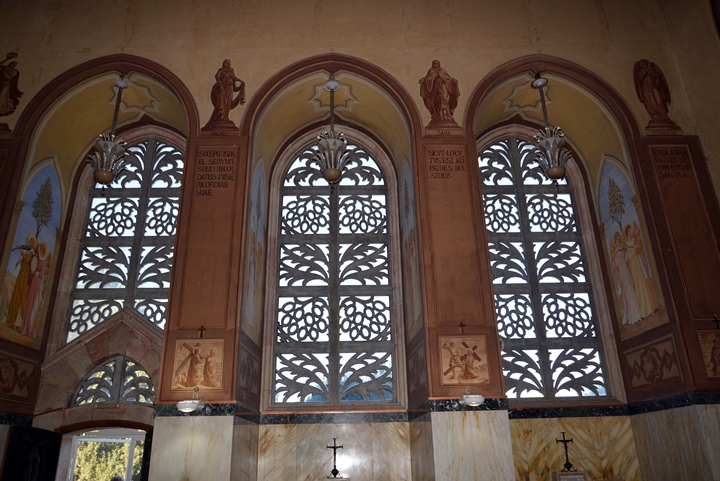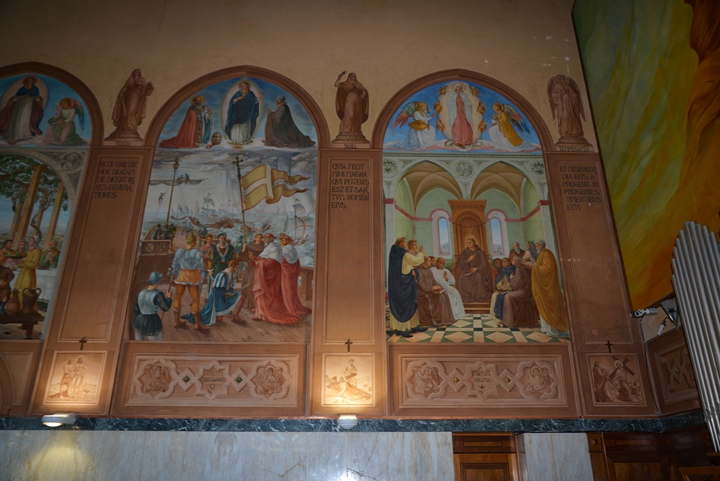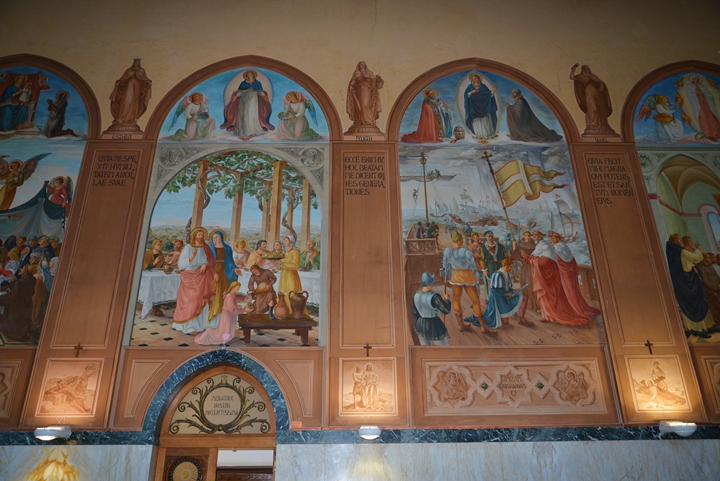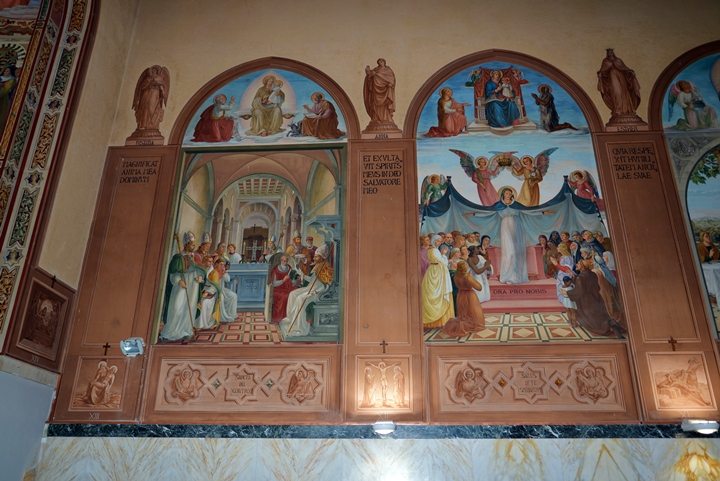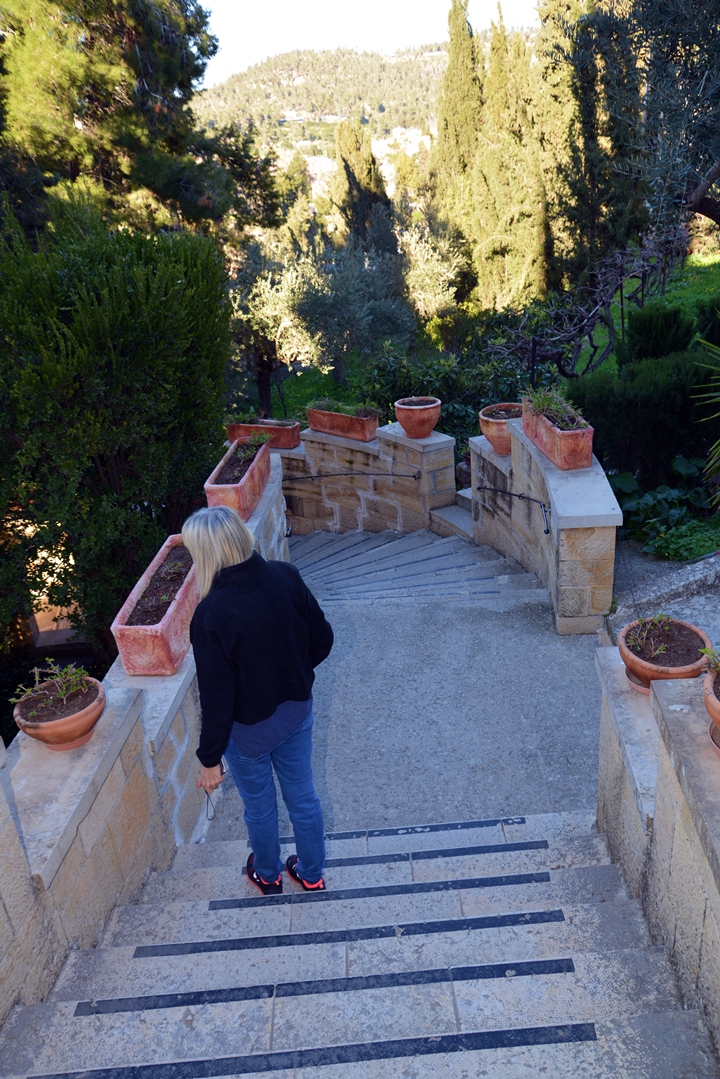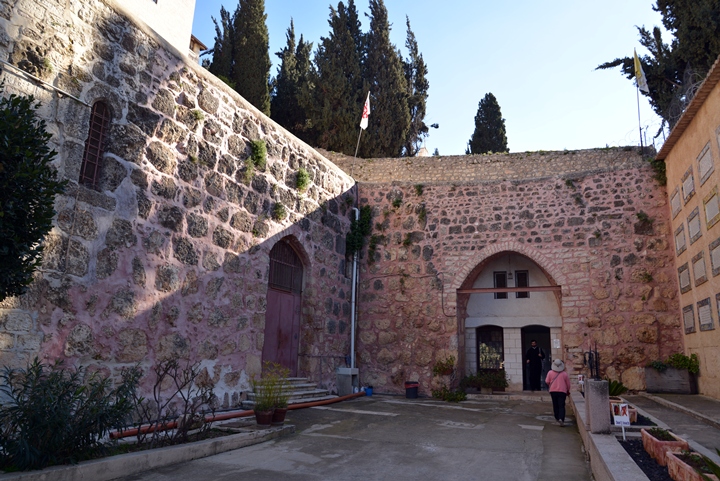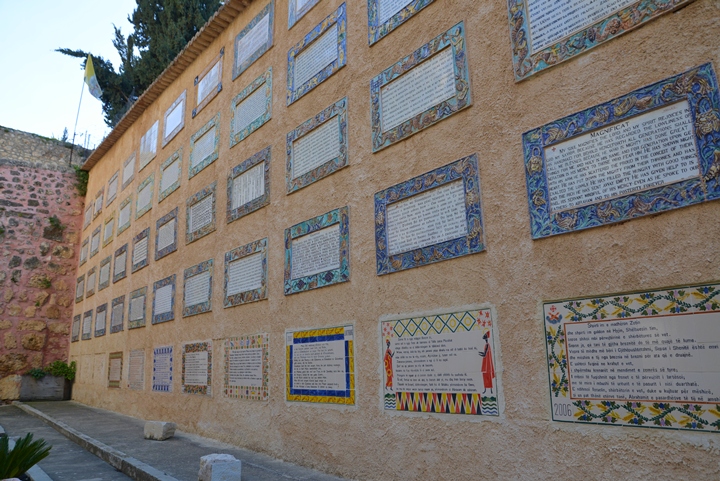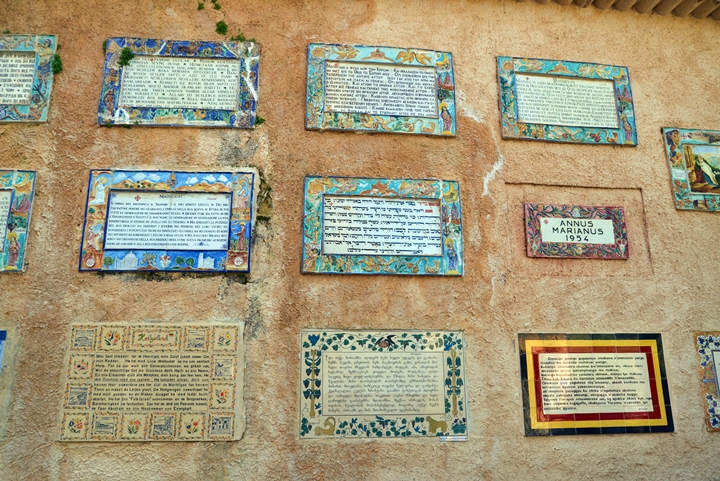A Franciscan church in Ein Kerem, on the west side of Jerusalem, named after Mary’s visit to the summer house of the parents of John the Baptist .
Home > Sites > Jerusalem > Ein Kerem > Visitation Church
Contents:
Overview
Location
History
Photos
* General view
* Exterior
* Lower Church
* Upper Church
* Courtyard
Biblical Refs
Etymology
Links
Overview:
The Visitation Church is a Catholic church located in the Ein Kerem neighborhood of Jerusalem, Israel. It marks the traditional site where Mary, the mother of Jesus, visited Elizabeth, the mother of John the Baptist, as described in the New Testament. Luke 1:39: “And Mary arose in those days, and went into the hill country with haste, into a city of Juda”
The church was built in the mid-20th century on the ruins of earlier churches and chapels that had been destroyed over the centuries. The current building was designed by Italian architect Antonio Barluzzi and completed in 1955.
The church’s architecture is distinctive, with a series of arches framing the entrance and a white dome rising above the building. Inside, visitors can see a statue of Mary and Elizabeth, as well as a series of mosaics depicting scenes from the visitation story.
The Visitation Church is an important pilgrimage site for Catholics, and it is open to visitors of all faiths. It is located in a picturesque area of Ein Kerem, which is known for its winding streets, historic homes, and beautiful gardens.
Location:
The Visitation church is located in the village of Ein Kerem, west of Jerusalem (8KM from the center), on the hillside facing the south side of the village.
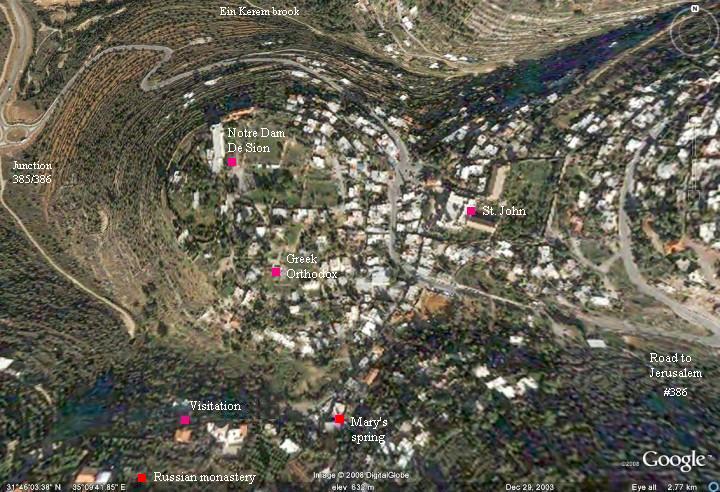
History:
-
Roman
According to Christian tradition, the village was a summer house for Zacharias and Elizabeth, parents of John the Baptist. The village was called “city of Juda” in the description of the visit by Luke.
Elizabeth (Elisheva) was the cousin of Mary, mother of Jesus. As per Luke, Mary visited Elizabeth when both were pregnant (hence the name – Church of visitation). During the visit, the baby leapt with joy in Elizabeth’s womb and Elizabeth was filled with the Holy Spirit, knowing Mary that she is about to give birth to the son of God. Mary then stayed with her cousin for 3 months until John was born.
John is an important figure in Christianity , and regarded as the “forerunner” – since John Baptized Jesus, and proclaimed Jesus as the Messiah.
-
Byzantine
The village and the spring is Holy for Christians, and several churches and monasteries were built during the Byzantine period. The visitation Crusaders church, on its “upper” floor, was built over one of them.
-
Crusaders
The Crusaders rebuilt some of the ruined Byzantine churches. The upper floor of the visitation church shows remains of the Crusaders church, especially on the south wing.
-
Ottoman period
PEF Survey: The area of Ein Kerem (Ain Karim) was examined in the Palestine Exploration Foundation (PEF) survey (1866-1877) by Wilson, Conder and Kitchener. The map below is a section of their survey results.
Part of map sheet 17 of Survey of Western Palestine, by Conder and Kitchener, 1872-1877.
(Published 1880, reprinted by LifeintheHolyLand.com)
The sites of Ein Kerem are described in their report (Vol 3, Sheet XVII, pp 60-61), and the following text relates to the Visitation Church:
“On the southern hill west of the spring (‘Ain Sitti Miriam), and close to the new Russian hospice, ruins were discovered by the Latins, in 1861, in building the new Chapel of the Summer-House of Zacharias.
The grounds were excavated to a depth of 15 to 20 feet, and the lower story of the old church (mentioned by John Poloner (1422) as having a subterranean and an upper chapel) was found.
All that can now be seen is the recent reconstruction, except a small cave, or vault, south of the altar, which is at the east end. A piece of stone is here shown which melted like wax, and hid John the Baptist, as an infant, from Herod’s soldiers. Outside this chapel on the south are arches and vaults in ruins, remains of a former monastery. The masonry is of good size and finish, some stones drafted. A courtyard is entered from the west, and a stone rib, with low point, rises from a massive pier ; these are remains of a vault of which the rag-work has disappeared.
There is diagonal dressing on the stones, but no masons’ marks occur. A narrow staircase leads up from the cloister north of the court to a chapel above that before noticed. Only the foundations of its walls remain ; the apse and part of a stone altar are traceable ; the interior was once covered with plaster and painted in fresco. There are many graffiti on the plaster, and on one stone a rude cutting representing the highpriest’s breastplate no doubt due to the tradition which erroneously supposes Zacharias to have been a high-priest. On the south side of the apse is the piscina. South of this chapel are remains of cells and steps, the rock being scarped. These ruins are partly hid by the soil of an orchard, which once covered the entire site, and in which the chapels and other buildings were found buried. Revisited 20th July, 1881″.
-
Ottoman and Modern times
The visitation church was reconstructed in 1955. This is a Franciscan church, built in 1955 and designed by the Italian famous church architect, Antonio Barluzzi, who also designed other churches such as the Mount of Beatitudes, Dominus Flevit and Basilica of Agony.
Photos:
(a) General views:
The facade of the visitation church is seen below, behind the gate.
Click on the photos to view in higher resolution…
The visitation church is located on a southern hill above Ein Kerem. A path leads from the valley, near Mary’s spring, to the church. The photo below shows a view of the path. The walls of the church is seen on the right side. On the sunny side of the center of the village of Ein Kerem is the church of St. John with its high bell tower.
Some photos are by Uncle Ronnie. He was fascinated from Ein Kerem and highly recommends to visit this site.
(b) Church Exterior
A closer view of the church, with a new mosaic painting on its wall. The sign reads in Latin “(Custodia) Terrae Sanctae” or: “Custodians of the Holy Land”, since the Franciscans are the official custodians of the Holy places since 1342.
The 5-cross symbol on the left is the Franciscan’s symbol. This symbol was the Crusaders sign of Jerusalem, and was adapted by the Franciscans. It is based on the 5 Holy wounds of the crucifixion of Jesus (2 in the hands, 2 in the legs, and one in the chest).
The mosaic illustrates the visit of Mary. She is shown riding a donkey; in the background is the village of Nazareth, her home town, and the place of her visit (“Ain Karim”).
The verse under the illustration is in Latin, from Luke 1, 39: “”And Mary arose in those days, and went into the hill country with haste, into a city of Juda”. The city of Juda is, according to the tradition, located in Ein Karem.
(c) Lower Church
The church has two floors, with prayers halls on both floors. The entrance to the lower floor is on the west side. Ancient hewn rocks are embedded in the walls of the Church.
Inside the church is the altar on the left side, an entrance to a cistern on the right, and a Holy rock on the right wall. On the ceiling are paintings of various Biblical scenes.
The following photos are of the three ceiling panels illustrations:
Left panel: In the photo below is the painting of Zacharias, the father of John, who served as a priest in the temple. As per Luke 1,5: “…a certain priest named Zacharias, of the course of Abia: and his wife was of the daughters of Aaron, and her name was Elisabeth”.
Center panel: The scene below shows the visit of Mary in Ein Kerem, meeting Elizabeth. Both women were pregnant at that time – Mary with Jesus and Elizabeth with John. As per Luke 1: 40-41: “…and Mary … entered into the house of Zacharias, and saluted Elisabeth. And it came to pass, that, when Elisabeth heard the salutation of Mary, the babe leaped in her womb; and Elisabeth was filled with the Holy Ghost”.
Right panel: Another scene shows the Roman soldiers prosecuting the mothers and killing their children in Bethlehem. This is according to Matthew 2: 16: Then Herod, when he saw that he was mocked of the wise men, was exceeding wroth, and sent forth, and slew all the children that were in Bethlehem, and in all the coasts thereof, from two years old and under, according to the time which he had diligently enquired of the wise men.”
From the church, on the right side of the altar, is a tunnel that leads to an ancient cistern, as seen below.
From this cistern, as per the tradition, John and his parents drank from the water.
In another corner is the spot where – according to tradition – John hid from the Romans behind a rock. The Latin inscription above it reads: In Hac Petra Elisabeth Johannem abscondisse traditur ( “In this rock Elizabeth hid John”).
A courtyard is located on the north side of the lower Church. Above is the second level, where the Upper Church is located.
(d) Upper Church
The Upper Church is larger, and also decorated with colorful illustrations of Christian history. It is based on Crusader period Church, which itself was built on Byzantine period foundations.
A closer view of the main altar on the east side of the Church is below.
On the rear western side of the Church is a pipe organ:
Along the north side of the Church are decorated windows, with illustrations on both sides of each window.The entrance door is located on the north west side, beneath the leftmost window.
The following photos show different panels on the south wall of the church. The right panel illustrates a famous Franciscan teacher, John Duns Scotus, who in 1307 argued on the purity of Mary. The left panel illustrates the 1571 victory of the Christians over the Ottomans in the naval battle near Lepanto, Greece.
The left panel below, just above the door, shows the event of the first miracle of Jesus – turning water to wine in a wedding in Cana.
Another set of panels on the east side of the south wall is seen below.
An external staircase on the north side connects the upper church to the lower church and courtyard.
(e) Courtyard:
On the west side of the lower church is an open courtyard.
On the west side of the courtyard is a collection of inscriptions in many languages. The inscription is a verse describing the visitation event, “Magnificant” – which means the Song of Mary – an ancient hymn of Mary.
The “Magnificant” hymn recalls the song of Mary while visiting her cousin in Ein Karem, as per Luke 1:46-55. After Elizabeth praises Mary for her faith, Mary sings the Magnificat in response.
A sleek statue of the meeting of Mary and Elizabeth are on the side of the wall. There is normally a long line of visitors who wait to take their photos with the statue.
Biblical:
Luke 1: 39-56:
The visit of Mary to the house of Zacharias, father of John the Baptist, in Ein Kerem (“city of Juda”).
“And Mary arose in those days, and went into the hill country with haste, into a city of Juda; And entered into the house of Zacharias, and saluted Elisabeth. And it came to pass, that, when Elisabeth heard the salutation of Mary, the babe leaped in her womb; and Elisabeth was filled with the Holy Ghost: And she spake out with a loud voice, and said, Blessed art thou among women, and blessed is the fruit of thy womb. And whence is this to me, that the mother of my Lord should come to me? For, lo, as soon as the voice of thy salutation sounded in mine ears, the babe leaped in my womb for joy. And blessed is she that believed: for there shall be a performance of those things which were told her from the Lord. And Mary said, My soul doth magnify the Lord, And my spirit hath rejoiced in God my Saviour. For he hath regarded the low estate of his handmaiden: for, behold, from henceforth all generations shall call me blessed. For he that is mighty hath done to me great things; and holy is his name. And his mercy is on them that fear him from generation to generation. He hath shewed strength with his arm; he hath scattered the proud in the imagination of their hearts. He hath put down the mighty from their seats, and exalted them of low degree. He hath filled the hungry with good things; and the rich he hath sent empty away. He hath holpen his servant Israel, in remembrance of his mercy; As he spake to our fathers, to Abraham, and to his seed for ever. And Mary abode with her about three months, and returned to her own house”.
Etymology (behind the name):
- Kerem – Hebrew: vineyard. As in 1 Kings 23 1: “”And it came to pass after these things, that Naboth the Jezreelite had a vineyard”.
- Ein, Ma’ayan – Hebrew: spring. Based on “Ma’im” – water. There are dozens of references in the Bible, since water was a major factor in this dry land.
- Ein Kerem (Karem) – the spring of the vineyard.
- BetHaccerem – Hebrew: The house of the vineyard. Beth – house.
- Zacharias – Hebrew: God (Iah) will remember (Zachar) him. Zacharias was a priest, a relative of Jesus and John’s father. There are forms of the name – such as Zachariah son of Barachiah – the 6th C BC prophet – who is also referred in the new testament (Matthew 23 35).
- John – the Baptist. from Hebrew, “Yochanan”, which means: Yo (God) + Chanan (Pardoned). Thus the name in Hebrew means ” God has pardoned”. Biblical Reference: Mark 1 4,5: “John did baptize in the wilderness…in the river of Jordan”.
- Elizabeth – from Hebrew: “My God is my oath”; Eli – my God, Sheva – Hebrew for oath- Shvuah (also: seven).Mother of John the Baptist. There are other Elisheva in the Bible – a wife of Aaron (Exodus 6 23: “And Aaron took him Elisheba, daughter of Amminadab, sister of Naashon, to wife; and she bare him Nadab, and Abihu, Eleazar, and Ithamar”).
Links:
On the visitation church:
Jerusalem archaeological survey (pdf, Hebrew):
* BibleWalks sites in Ein Kerem:
- Overview of Ein Kerem
- Mary’s spring
- St. John Ba Harim
- Greek Orthodox
- Sisters of Lady of Zion
- Russian Convent
On Religion:
BibleWalks.com – walk with us through the sites of the Holy Land
Ein Kerem (Overview)<<<—previous Jerusalem site–<<< All Sites >>>—> Mary’s spring
![]()
This page was last updated on Mar 12, 2023 (add new overview)
Sponsored links:

